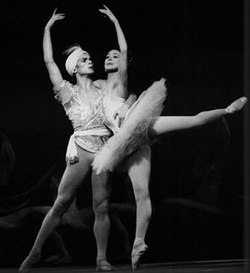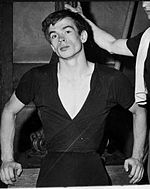cultură şi spiritualitate
Rudolf Nureyev
From Wikipedia
| Rudolf Nureyev | |
|---|---|
 Rudolf Nureyev |
|
| Born | Rudolf Khametovich Nureyev 17 March 1938(1938-03-17) Irkutsk, Siberia |
| Died | 6 January 1993 (aged 54) Paris, France |
| Occupation | Dancer, actor |
Rudolf Khametovich Nureyev (Tatar: Rudolf Xämät ulı Nuriev, Russian: Рудольф Хаметович Нуреев) (17 March 1938 – 6 January 1993) was a Tatar dancer from the Soviet Union, primarily known for his work in ballet. Nureyev's artistic skills explored expressive areas of the dance, providing a new rôle to the male ballet dancer who once served only as support to the women.
He defected to the West, despite KGB efforts to stop him.[1] According to KGB archives studied by Peter Watson, Nikita Khrushchev personally signed an order to kill Nureyev.[2]
Early life and career at the Kirov
Nureyev was born on a Trans-Siberian train near Irkutsk, Siberia, Soviet Union, while his mother Farida was travelling to Vladivostok, where his father Hamat, a Red Army political commissar, was stationed [3]. He was raised as the only son in a Tatar family in a village near Ufa in Soviet republic of Bashkiria. When his mother smuggled him and his sisters into a performance of the ballet "Song of the Cranes", he fell in love with dance. [3] As a child he was encouraged to dance in Bashkir folk performances and his precocity was soon noticed by teachers who encouraged him to train in Leningrad. On a tour stop in Moscow with a local ballet company, Nureyev auditioned for the Bolshoi ballet company and was accepted. However, he felt that the Kirov Ballet school was the best, so he left the local touring company and bought a ticket to Leningrad.[4]
Owing to the disruption of Soviet cultural life caused by World War II, Nureyev was unable to enroll in a major ballet school until 1955, aged 17, when he was accepted by the Leningrad Choreographic School, the associate school of the Kirov Ballet.
Alexander Ivanovich Pushkin took an interest in him professionally and allowed Nureyev to live with him and his wife. Upon graduation, Nureyev continued with the Kirov and went on to become a soloist.
In his three years with the Kirov, he danced fifteen rôles, usually opposite his partner, Ninel Kurgapkina, with whom he was very well paired, although she was almost a decade older than him [5]. He became one of the Soviet Union's best-known dancers and was allowed to travel outside the Soviet Union, when he danced in Vienna at the International Youth Festival. Not long after, for disciplinary reasons,[citation needed] he was told he would not be allowed to go abroad again. He was confined to tours of the Soviet republics.
Defection
In 1961, the Kirov's leading male dancer, Konstantin Sergeyev, was injured, and Nureyev was chosen to replace him on the Kirov's European tour. In Paris, his performances electrified audiences and critics,[citation needed] but he broke the rules about mingling with foreigners, which alarmed the Kirov's management.[citation needed] The KGB wanted to send him back to the Soviet Union immediately. As a subterfuge, they told him that he would not travel with the company to London to continue the tour because he was needed to dance at a special performance in the Kremlin. When that didn't work they told him his mother had fallen severely ill and he needed to come home straight away to see her[citation needed] He knew these were lies and believed that if he returned to the U.S.S.R., he would likely be imprisoned, because KGB agents had been investigating him.
On June 16, 1961 at the Le Bourget Airport in Paris, Rudolf Nureyev defected with the help of French police. Within a week, he was signed up by the Grand Ballet du Marquis de Cuevas and was performing The Sleeping Beauty with Nina Vyroubova. On a tour of Denmark he met Erik Bruhn, a dancer who became his lover, his closest friend and his protector for many years.[6]
Although he petitioned the Soviet government for many years to be allowed to visit his mother, he was not allowed to do so until 1989, when his mother was dying and Mikhail Gorbachev consented to the visit. During this visit, he was invited to dance with the Kirov Ballet at the Maryinsky theatre in Leningrad. The visit gave him the opportunity to see many of the teachers and colleagues he had not seen since he defected, including his first ballet teacher in Ufa.[citation needed]
Royal Ballet
Nureyev's first appearance in Britain was at a ballet matinée organised by The Royal Ballet's Prima Ballerina Dame Margot Fonteyn. The event was held in aid of the Royal Academy of Dance, a classical ballet teaching organisation of which she was President. He danced "Poeme Tragique", a solo choreographed by Frederick Ashton, and the Black Swan pas de deux from Swan Lake.
Dame Ninette de Valois offered him a contract to join The Royal Ballet as Principal Dancer. His first appearance with the company was partnering Margot Fonteyn in Giselle on 21 February 1962. Fonteyn and Nureyev would go on to form a partnership. Nureyev stayed with the Royal Ballet until 1970, when he was promoted to Principal Guest Artist, enabling him to concentrate on his increasing schedule of international guest appearances and tours. He continued to perform regularly with The Royal Ballet until committing his future to the Paris Opera Ballet in the 1980s.
Fonteyn and Nureyev

Rudolph Nureyev and Margot Fonteyn became longstanding dance partners and continued to dance together for many years after Nureyev's departure from the Royal Ballet. Their last performance together was in Baroque Pas de Trois on 16 September 1988 when Fonteyn was 69, Nureyev was aged 50, with Carla Fracci also starring, aged 52. Nureyev once said of Fonteyn that they danced with "one body, one soul".
Together Nureyev and Fonteyn premiered Sir Frederick Ashton's ballet Marguerite and Armand, a ballet danced to Liszt's B minor piano sonata, which became their signature piece. They always completely sold out the house. Kenneth Macmillan was forced to allow them to premiere his Romeo and Juliet, which was intended for two other dancers, Lynn Seymour and Christopher Gable. Films exist of their partnership in Les Sylphides, Swan Lake, Romeo and Juliet, and other rôles.
Film and television
In 1962, Nureyev made his screen debut in a film version of Les Sylphides. In 1977 he played Rudolph Valentino in Ken Russell's Valentino, but he decided against an acting career in order to branch into modern dance with the Dutch National Ballet in 1968. In 1972, Robert Helpmann invited him to tour Australia with his own production of Don Quixote [7], his directorial debut. The film version (1973) features Nureyev, Lucette Aldous as Kitri, Helpmann as Don Quixote and artists of the Australian Ballet.
During the 1970s, Nureyev appeared in several films and toured through the United States in a revival of the Broadway musical The King and I. He was one of the guest stars on the television series The Muppet Show where he danced in a parody called "Swine Lake," sang "Baby It's Cold Outside" in a hot tub duet with Miss Piggy, and sang and danced in the show's finale, "Top Hat"[8]. In 1982, he became a naturalized Austrian. In 1983, he was appointed director of the Paris Opera Ballet, where, as well as directing, he continued to dance and to promote younger dancers. He remained there as a dancer and chief of choreography until 1989. Among the dancers he groomed were Sylvie Guillem, Isabel Guerin, Manuel Legris, Elisabeth Maurin, Elisabeth Platel, Charles Jude, and Monique Loudieres. Despite advancing illness towards the end of his tenure, he worked tirelessly, staging new versions of old standbys and commissioning some of the most ground-breaking choreographic works of his time. His own Romeo and Juliet was a popular success.
Personality
Nureyev was notoriously impulsive and did not have much patience with rules, limitations and hierarchical order.[citation needed] His impatience mainly showed itself when the failings of others interfered with his work. Most ballerinas with whom he danced, including Antoinette Sibley, Gelsey Kirkland and Annette Page paid tribute to him as a considerate partner.
He socialized with Freddie Mercury, Jackie Kennedy Onassis, Mick Jagger, Liza Minnelli, Andy Warhol and Talitha Pol, but developed an intolerance for celebrities.[citation needed] He kept up old friendships in and out of the ballet world for decades, and was considered to be a loyal and generous friend.[citation needed] He was known as extremely generous to many ballerinas, who credit him with helping them during difficult times. In particular, the Canadian ballerina Lynn Seymour - distressed when she was denied the opportunity to premiere Macmillan's Romeo and Juliet - says that Nureyev often found projects for her even when she was suffering from weight issues and depression and thus had trouble finding rôles.[citation needed] He is also said to have helped an elderly and increasingly impoverished Tamara Karsavina.[citation needed]
By the end of the 1970s, when he was in his 40s, he continued to tackle big classical rôles. However by the late 1980s his diminished capabilities disappointed his admirers who had fond memories of his outstanding prowess and skill.[citation needed] Towards the end of his life, in the later stages of AIDS, he worked on productions for the Paris Opera Ballet. His last work was a production of La Bayadère which closely follows the Kirov Ballet version he danced as a young man.
Influence
Nureyev's influence on the world of ballet changed the perception of male dancers; in his own productions of the classics the male rôles received much more choreography.[citation needed] Another important influence was his crossing the borders between classical ballet and modern dance by performing both.[citation needed] Today it is normal for dancers to receive training in both styles, but Nureyev was the originator, and the practice was much criticized in his day.[citation needed] (Though Gene Kelly had done much to combine the two styles in film, he came from a more Modern Dance influenced "popular dance" environment, Nureyev made great strides in gaining acceptance of Modern Dance in the "Classical Ballet" sphere)
Final years and death

When AIDS appeared in France around 1982, Nureyev took little notice. For several years he simply denied that anything was wrong with his health. When, about 1990, he became undeniably ill, he is said to have attributed the symptoms to other ailments. He tried several experimental treatments but they did not stop his deteriorating health.
In March 1992, Rudolf Nureyev, living with advanced AIDS, visited Kazan and appeared as a conductor in front of the audience at Musa Cälil Tatar Academic Opera and Ballet Theater in Kazan, who now presents the Rudolf Nureyev Festival in Tatarstan [10][11]
At his last appearance, a 1992 production of La Bayadère at the Palais Garnier, Nureyev received a standing ovation.[citation needed] The French Culture Minister, Jack Lang, presented him with France's highest cultural award, the Commandeur de l'Ordre des Arts et des Lettres. He died in Paris a few months later, aged 54.
His grave, at a Russian cemetery in Sainte-Geneviève-des-Bois near Paris, features a tomb draped in a mosaic of an oriental carpet. Nureyev was an avid collector of beautiful carpets and antique tex
Răspunsuri la Aceste Discuţii
© 2024 Created by altmarius.
Oferit de
![]()
Embleme | Raportare eroare | Termeni de utilizare a serviciilor













